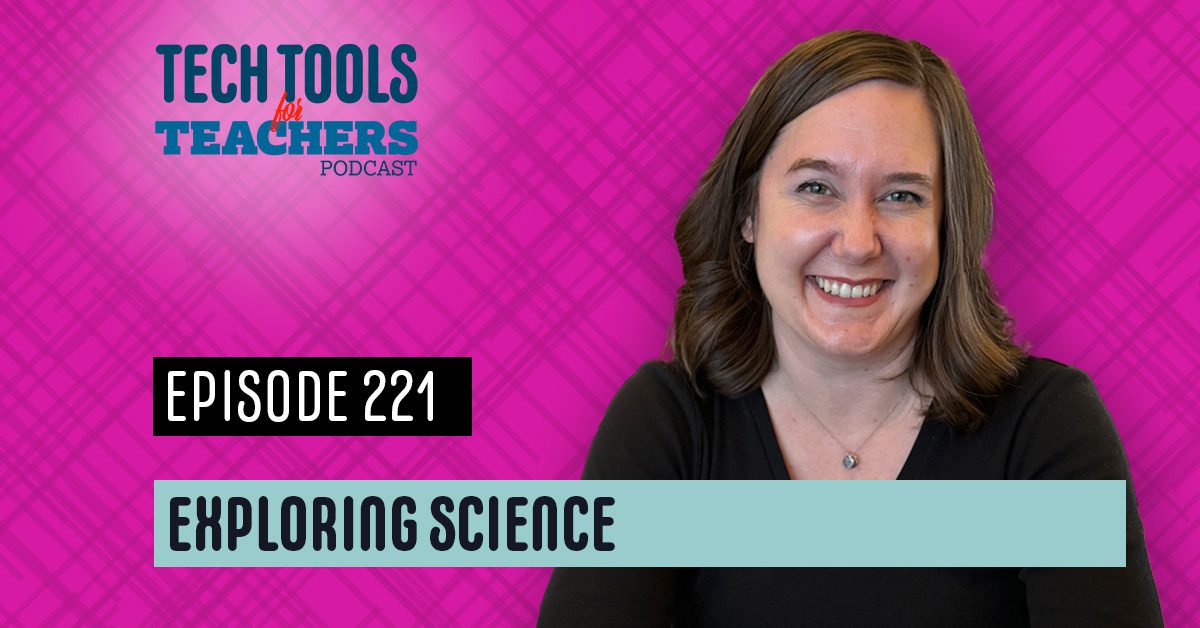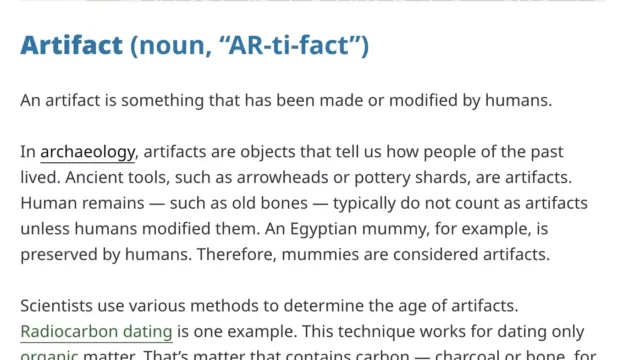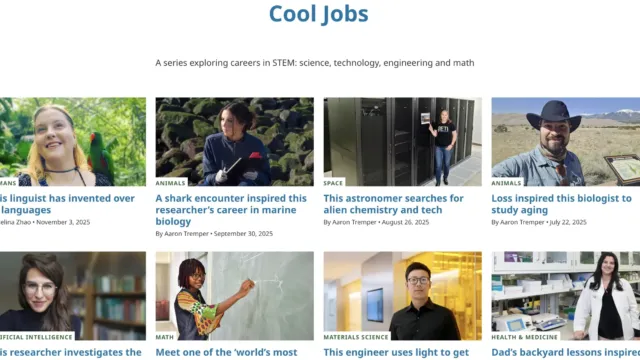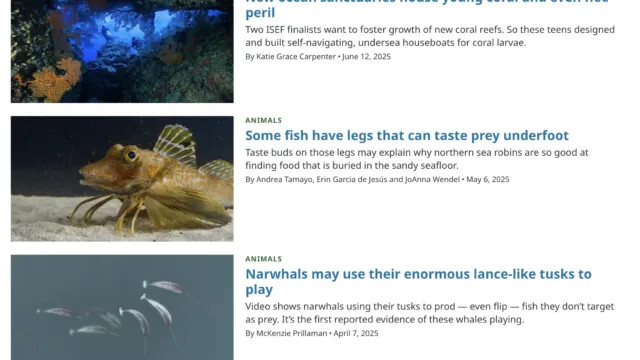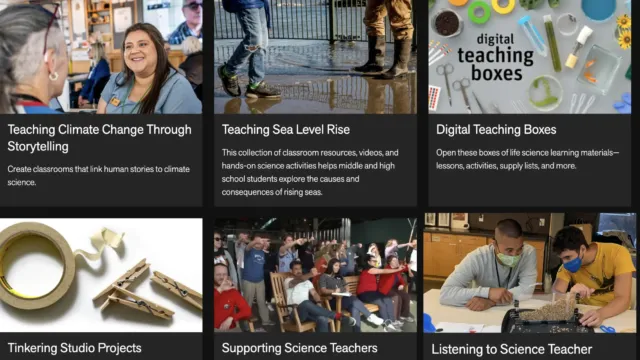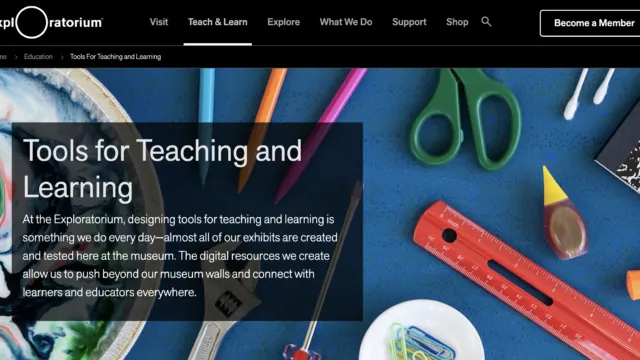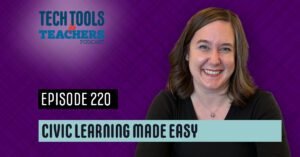[00:00:00] Shanna Martin: Thanks for listening to the Tech Tools for Teachers podcast, where each week we talk about a free piece or two of technology that you can use in your classroom. I’m your host, Shanna Martin. I’m a middle school teacher, technology and instructional coach for my district,
[00:00:32] Fuzz Martin: and I’m our producer and husband, Fuzz Martin.
[00:00:34] Fuzz Martin: And I only here with you because we have such good chemistry.
[00:00:38] Shanna Martin: Uh, cute.
[00:00:41] Fuzz Martin: Yes. And I also happen to have a whole bunch of podcasting equipments that helps as well.
[00:00:47] Shanna Martin: And it works to have your round occasion. Yeah.
[00:00:49] Fuzz Martin: Yes.
[00:00:52] Shanna Martin: We are talking about science this week. Science. We’ve had a few episodes about science.
[00:00:57] Fuzz Martin: She blinded me with science,
[00:00:59] Shanna Martin: but there was some other cool things that I wanted to share.
[00:01:02] Fuzz Martin: Cool.
[00:01:03] Shanna Martin: So I’m sharing about more cool sciencey things.
[00:01:05] Fuzz Martin: I dig it.
[00:01:06] Shanna Martin: And we are here in November.
[00:01:09] Fuzz Martin: Yeah.
[00:01:09] Shanna Martin: And
[00:01:10] Fuzz Martin: the science
[00:01:11] Shanna Martin: is, anybody is excited about the weather?
[00:01:13] Fuzz Martin: Mm-hmm.
[00:01:15] Shanna Martin: In Wisconsin. We had snow today.
[00:01:19] Fuzz Martin: Yes. Flurries. Nothing. Flurries. Nothing.
[00:01:21] Shanna Martin: It depends on what part though. ’cause there was snow.
[00:01:23] Fuzz Martin: Yeah.
[00:01:24] Shanna Martin: In
[00:01:24] Fuzz Martin: some people got
[00:01:24] Shanna Martin: other areas.
[00:01:25] Fuzz Martin: Snow on the ground. We got
[00:01:27] Shanna Martin: flurries.
[00:01:27] Fuzz Martin: Flurries.
[00:01:28] Shanna Martin: But it’s official.
[00:01:29] Fuzz Martin: Yep.
[00:01:29] Shanna Martin: There’s snow and
[00:01:31] Fuzz Martin: which means
[00:01:33] Shanna Martin: science.
[00:01:34] Fuzz Martin: It’s almost the holidays.
[00:01:35] Shanna Martin: It’s ish.
[00:01:37] Fuzz Martin: Yeah.
[00:01:37] Shanna Martin: So with our little chat about science tools, Ooh. There’s two different websites I’m gonna talk about today. That are very cool and I kind of pulled some highlights that can go with both of them.
[00:01:50] Shanna Martin: There is, between both sites a huge collection of resources. So no matter what type of science you teach or if you’re just trying to engage students in some STEM skills, whether it’s in an enrichment class or even an indoor recess or a fun problem solving kind of afternoon, like there is a lot of cool resources.
[00:02:10] Shanna Martin: There are activities for all ages. So ranging from like 4K all the way through, um, along with resources that people could use, like parents could use at home, or things that you can build in the classroom. Both could be independent or they could be in groups kind of thing. There’s a lot of like promoting of deeper thinking, so here’s some information, but let’s like apply this to other parts of your life and think deeper about it.
[00:02:36] Shanna Martin: Lots of them bring awareness of, relevant topics. Specifically one of the sites I’m gonna talk about. It gives you like very relevant, like news related science information. Mm-hmm. Which is great. And then there’s tons of teacher and student tools. So you can use it as a teacher, you can have your students use it without you, you can use it together as class.
[00:02:56] Shanna Martin: So just lots of cool resources. So I was very excited too. I am very excited to share these sites with everybody today. The first site we’re gonna talk about is called Science News Explorers. Science News Explorers. And what’s cool is it’s actually based on the science news explorers, that there’s an actual physical.
[00:03:18] Shanna Martin: Like magazine that you can have sent to your classroom, you have to pay for it then. But they have like a subscription and these are all of the resources that are available for free. So even if you don’t subscribe to the magazine for your classroom, there’s a ton of resources that you can use.
[00:03:35] Fuzz Martin: Yeah,
[00:03:36] Shanna Martin: so the site itself is S-N-E-X-P-L-O-R-E s.org.
[00:03:46] Fuzz Martin: SN explorers.org?
[00:03:47] Shanna Martin: Correct.
[00:03:48] Fuzz Martin: Sn explorers do.org.
[00:03:50] Shanna Martin: Correct. So Science News explorers. And once you get there, you’re gonna find whatever the newest articles are that they’ve written
[00:03:58] Fuzz Martin: mm-hmm.
[00:03:59] Shanna Martin: Which are very relevant. Like daily. There’s a new article, there is just Off the top, scientists caught a black hole ringing like a bell.
[00:04:09] Shanna Martin: To our brains, your red is my red.
[00:04:12] Fuzz Martin: Me, Roja. Roja.
[00:04:15] Shanna Martin: Good job. Um, this link,
[00:04:18] Fuzz Martin: I can’t see red, but I can say very minor things in, in Spanish
[00:04:22] Shanna Martin: has in, invented over 20 languages. So it’s got each article. It also has like a word of the week, which is great for vocabulary. I kind talk about that in a second.
[00:04:32] Shanna Martin: They have like practice analysis and then different types of explainers of like parts and things in your life, like vitamins and stuff like that. So the best thing you can do is. It looks like a little newspaper and you go to it.
[00:04:44] Fuzz Martin: Mm-hmm.
[00:04:45] Shanna Martin: There’s science news, which will be right away, but if you go to the menu, so it’s kind of in the right hand, like upper quadrant of the website.
[00:04:54] Shanna Martin: If you click on menu, you’ll find all their stories. Then you’ll find if you click on collections, you can find specific things. So action for the earth, artificial intelligence. Learn about, so there’s different categories that you can like check out if you go back to the menu. Their explainers are cool.
[00:05:13] Shanna Martin: It’s background pieces for deeper dive into a broader range of like pivotal topics. So you can pull like physics and then how you make a pitched ball curve at your will, like a baseball. Then it has like a little video that goes through it and then it will connect with, an article and the information that it goes to.
[00:05:32] Shanna Martin: So it kinda walks you through the steps of different things, which is very cool. Again, if you’re looking for deeper thinking with your students. And I would say any of these could be used. Some of these articles will definitely be like upper elementary through high school.
[00:05:46] Fuzz Martin: Mm-hmm.
[00:05:47] Shanna Martin: But you could use them as topics to get your students thinking and brainstorming very easily.
[00:05:53] Shanna Martin: Something I really like is the word of the week. If you click on that, it will take you through, like I’m scrolling through a little bit, so you can kinda see scientists say transplant, and then it will talk about. How to say transplant, it will give you the definition of transplant. It will show you how to use it in a sentence, and then it talks about like power words and then how like those are relevant as well.
[00:06:19] Shanna Martin: So there’s a whole like vocab focus, which again would be super great. Maybe not just science class, but you could use it in ELA if you’re writing with nonfiction or different types of things like that. They have. The experiment section, which if you click, and again, this is all in the menu, if you scroll through experiments, it will experiment m and ms.
[00:06:38] Shanna Martin: Geometry is a science project about m and ms stand for measurements and models, and then it walks you through the objective, what you need cost under $20. Like it will tell you the materials that you need or don’t need. Concepts and questions and material and equipment. It walks you through everything that you would need as a teacher to set it up.
[00:07:02] Shanna Martin: Or again, if your students are gonna have like a little science fair, this would be a great way for them to find different experiments to do. There’s all kinds of ’em. If you click on comics, I thought this was really cool. If you go to comics and then you scroll down, I am gonna suggest see how hummingbirds sneak through small spaces.
[00:07:24] Fuzz Martin: Okay.
[00:07:24] Shanna Martin: And if you click on it, there’s a cute little hummingbird.
[00:07:28] Fuzz Martin: Oh yeah. Look at that
[00:07:28] Shanna Martin: and then keep scrolling.
[00:07:30] Fuzz Martin: Okay. Keep
[00:07:30] Shanna Martin: scrolling.
[00:07:31] Fuzz Martin: Oh, look at that. In graphic. Little tale
[00:07:33] Shanna Martin: wild thing. A graphic tale, how hummingbirds flutter through small spaces. And then it’s like a little comic about birds and hummingbirds.
[00:07:45] Shanna Martin: And then it shows like how they do what they do. And it’s all drawn out in cartoons, which I thought was really cool. And it gives you your power words. And it gives you like citations. Everything in here is cited, which I appreciate, and then it will connect you to like who wrote it and what it’s about.
[00:08:00] Shanna Martin: What I thought. What a cool way to inspire your kids to then make their own little comics about science so they could get a science concept and then they could do up a little drawing and make a little comic based on a science concept that you’re learning in class. This would be a great way to model that, and it’s really cute and it’s really interesting.
[00:08:19] Fuzz Martin: Yeah.
[00:08:20] Shanna Martin: So that’s under like the comics section.
[00:08:23] Fuzz Martin: I like the, uh, hummingbird. I’m just gonna scooch through here.
[00:08:26] Shanna Martin: Yes, it’s cute. Like it’s just cute and it’s in like, kid friendly terminology. It just makes sense. Mm-hmm. There’s an, an like analyze this section. I’m not gonna through all, and there’s so much information here.
[00:08:36] Fuzz Martin: Yeah.
[00:08:37] Shanna Martin: Action Earth. But the other thing I wanna highlight was cool jobs. If you click on that, I always think it’s super relevant to connect what you’re teaching to the future for students or why. And this whole section explore like explores careers in stem, science, technology, engineering, and math. And then it’s different people.
[00:08:56] Shanna Martin: So you can click on like animals, A shark encounter inspired by this researcher’s career in marine biology. You can click on it and then like she talks about her job as a marine biologist and then also like what she is learning about sharks. And if you wanna pursue a job in marine biology, what that looks like.
[00:09:15] Shanna Martin: So it’s a really cool way for kids to learn more about jobs that connect to science as well. Mm-hmm. And maybe not your typical jobs that everybody would see all the time.
[00:09:27] Shanna Martin: So yeah, the very, there’s a lot of very cool information. Mm-hmm. In this menu. Again, this is all free. They all have a like classroom questions. So if you’re looking at questions in your classroom, it will help students. Again, think more and brainstorm and think beyond what’s being put in front of them.
[00:09:48] Shanna Martin: So that’s just the menu section. I didn’t even get into the other sections where if you go under all the topics, you can pick one. Choose a topic, life, humans, earth, or space or tech.
[00:09:57] Fuzz Martin: I’ll go space.
[00:09:58] Shanna Martin: All right, if you click on the space button. It will then give you every article about different types of space.
[00:10:07] Shanna Martin: If you click on, like scientists say space junk, if you click on the article, then you have the option to
[00:10:15] Fuzz Martin: read it.
[00:10:16] Shanna Martin: Read it. You can, I know if the audio will come up, you’ll explain to you with the audio. Fine
[00:10:23] Computer Voice: to say.
[00:10:24] Shanna Martin: There you go.
[00:10:24] Computer Voice: Space junk. Space junk refers to trash left in space by humans. More than 36,500,
[00:10:32] Shanna Martin: so it’ll give you the audio for it, which is fantastic.
[00:10:35] Shanna Martin: If you keep scrolling, it says in a sentence, like it will explain it in a sentence.
[00:10:40] Fuzz Martin: Sure.
[00:10:41] Shanna Martin: There’s a collection of power words, which you have the option to read with your students, or you can print the list of power words so you have that as a vocab list if you want it to your vocab wall, which is awesome.
[00:10:51] Shanna Martin: And then there’s a little bit about the author, so there’s a bunch of resources that go with each of the articles that then would be helpful for you while you’re teaching in your classroom as well. So that’s under any one of the articles that you click on.
[00:11:05] Fuzz Martin: Very cool.
[00:11:05] Shanna Martin: Yeah, so Science News Explorers has so many great science resources that you can use in so many different classes without having to actually subscribe to the Science Explorers magazine.
[00:11:17] Shanna Martin: But if you would find it useful, you could do that as well. You know, if you have supplemental mm-hmm.
[00:11:21] Fuzz Martin: Like
[00:11:21] Shanna Martin: material in your classroom. But it’s really cool and there’s just lots of cool things to see and explore.
[00:11:27] Fuzz Martin: Ah, explore. Which is a good segue.
[00:11:30] Shanna Martin: It’s. Because we’re exploring Science
[00:11:35] Fuzz Martin: Exploratorium
[00:11:36] Shanna Martin: and the next site is Exploratorium.
[00:11:43] Shanna Martin: That sounds weird, but we’ll just go with it.
[00:11:45] Fuzz Martin: Yeah, well, yeah, it’s cool.
[00:11:46] Shanna Martin: Exploratorium is actually a place.
[00:11:49] Fuzz Martin: Oh,
[00:11:50] Shanna Martin: it’s place.
[00:11:52] Fuzz Martin: It is in San Francisco.
[00:11:53] Shanna Martin: It’s in San Francisco, and what’s crazy is off of Pier 15 in San Francisco. Like a billion years ago.
[00:11:59] Fuzz Martin: Yeah,
[00:11:59] Shanna Martin: you and I
[00:12:00] Fuzz Martin: we went
[00:12:00] Shanna Martin: there. Were there.
[00:12:01] Fuzz Martin: Yeah.
[00:12:01] Shanna Martin: But we did not go to the
[00:12:02] Fuzz Martin: Exploratorium.
[00:12:03] Fuzz Martin: We did not explore the Exploratorium.
[00:12:04] Shanna Martin: I know. Now I’m kind of sad. I think we need to go backs to San Go San Francisco. Well,
[00:12:07] Fuzz Martin: let’s go back. Sounds good.
[00:12:08] Shanna Martin: So Exploratorium,
[00:12:09] Fuzz Martin: what are you doing tomorrow?
[00:12:11] Shanna Martin: Yes, let’s just hop on a plane. Exploratorium the site Excel is X-P-L-O-R-A-T-O-R-I-U m.edu.
[00:12:24] Shanna Martin: exploratorium.edu. And obviously when you first click on it, you’re like, oh, it’s a place, which it is. It’s a place, it’s a very cool place to explore. But in addition to it being like a science museum
[00:12:40] Fuzz Martin: mm-hmm.
[00:12:40] Shanna Martin: A STEM museum, all kinds of cool things. If you click on. The menu bar on the Teach and Learn section.
[00:12:48] Shanna Martin: There are so many cool resources. So they have a collections called Resources for Educators. We love people who share information with educators. Um, they have professional development and things like that that you can do, that you can actually go there if you choose to. If you. Go under that section. They have classroom resources and in classroom resources they have like science snacks.
[00:13:12] Shanna Martin: Hmm. And you click on it. Low cost teacher tested activities for the classroom and for the curious, this is one of those where you could definitely do these in your classroom. You also could encourage STEM at home. Mm-hmm. Or if you’ve got parents are saying, Hey, I wanna do like. Engaging things at home with my kid.
[00:13:31] Shanna Martin: What can I do? So they have special snacks, collections. I love this. You can go, they have snacks with videos, the science of snacks. Anyway, so you can click on one of them. I’m gonna go with simple science snacks and then I’m gonna scroll down and I’m going to click on the head harp.
[00:13:52] Fuzz Martin: The head harp?
[00:13:53] Shanna Martin: Yeah.
[00:13:54] Shanna Martin: Okay. Tools, some materials. You wanna know what you need. A piece of string that’s three feet long.
[00:13:59] Fuzz Martin: Okay.
[00:14:01] Shanna Martin: That’s it.
[00:14:02] Fuzz Martin: Oh, all right. Well that’s easy enough.
[00:14:03] Shanna Martin: Yep. There’s like a to-do what’s going on? Going further.
[00:14:08] Fuzz Martin: Okay.
[00:14:09] Shanna Martin: Yeah. Sets it all up. They’re like little small, little tidbits of science information. It’s so cool.
[00:14:18] Shanna Martin: They also have all kinds of cool. Resources under Explore. So that’s the Teach and Learn section, which like teaches you specific things. If you click on Explore, it will give you, they have Explore from anywhere activities, and if you click on those, it is broken down by subject. So it can be really specific.
[00:14:38] Shanna Martin: Oh, astronomy, art, biochemistry, data, earth and science history, math. The nature of science, physics, it gives you, how many activities for each of the categories, and then also has it broken down by NGSS, so the National Science Standards and has it broken down by the science standards. It also has it broken down by grade bands, so you will find activities from P pre-K all the way through 12th grade, depending on what you need.
[00:15:06] Shanna Martin: And then we’ll also have activity type. So they have DIY exhibits versus like digital versus the science snacks and the little ones. There’s projects, there’s food recipes, a few of them. So there’s just different ways to break it down. What I also appreciate is, let’s pick one, I’m gonna do the ring game.
[00:15:26] Shanna Martin: So it’s a DIY exhibit. It will tell you ahead of time. Some of them require the use of tools or electronics. So like as a parent or as a teacher, you should know that it’s going to like have actual tools. This one uses an air blower, so a hair dryer. Okay. And then it also uses a hot glue gun and it gives you a picture of everything you’re gonna need.
[00:15:53] Shanna Martin: So it gives you a list and an image, like these are what we’re talking about. When you are picking out your tools, shows you how to make it, how to set the whole things up, and then as poses a question, what’s going on? What do you notice, what do you wonder? What do you wanna try? There’s troubleshooting tips and then you can build your own, which I love.
[00:16:15] Shanna Martin: And that’s all under, again, the explore in the activities section. So why don’t you pick a topic?
[00:16:22] Fuzz Martin: Oh, okay. Lemme see. Um, I was. Uh, let’s see.
[00:16:27] Shanna Martin: Like art chemistry.
Yeah,
[00:16:29] Fuzz Martin: physics.
[00:16:30] Shanna Martin: Physics. There’s a lot of physics. There’s 234 physics options.
[00:16:35] Fuzz Martin: Okay.
[00:16:35] Shanna Martin: Then you can go under it, breaks it down, electricity, energy, heat, light,
[00:16:40] Fuzz Martin: let’s say mechanics.
[00:16:41] Shanna Martin: Mechanics. Then you click on that and it breaks it down further for you. And I’m gonna click on the
[00:16:49] Fuzz Martin: parachute plummet.
[00:16:51] Shanna Martin: Great. Parachute plummet. Tools.
[00:16:54] Fuzz Martin: This reminds me of, making parachutes for G.I. Joes when I was kid. So
[00:16:58] Shanna Martin: totally. You need a paper napkin. You need
[00:17:02] Fuzz Martin: paper clip,
[00:17:03] Shanna Martin: four pieces of string. You need adhesive dots or tape.
[00:17:07] Shanna Martin: You need a paper clip. And then optional would be different types of string. Shows you the assemblies step-by-step process. The to-do and notice section, what’s going on? Going further, teaching tips. This would be great for students. You could set them up. This is a quick, like what can we do? Yeah. What is the physics behind it?
[00:17:27] Shanna Martin: And it gives you the option, it does give you the option to print them, so it will break it down for you. So it’s an easier print if you wanna just hand it out to kids and have them build in groups, you can. So again, there’s so many resources here in that explore section that you can build into your classroom and easily share it with students.
[00:17:45] Shanna Martin: And they can work independently or as groups or as a whole class. They also have a article section. That gives you more information that kind of connects with the different activities along with additional science information. So Exploratorium, it’s an actual place, but it also has a ton of cool resources on their website to encourage science and STEM exploration in your classroom.
[00:18:08] Shanna Martin: And there’s just some fun things that you could put together when you need. Fire up your class and engage them in discussion.
[00:18:17] Fuzz Martin: And if you’re going there, they have a restaurant called the Tinkering Table and also a coffee shop called Catalyst Coffee Lab.
[00:18:23] Shanna Martin: So, and now we’re just gonna plan a trip.
[00:18:24] Fuzz Martin: Yep. That was me.
[00:18:25] Shanna Martin: And we’re gonna go
[00:18:25] Fuzz Martin: planning our trip
[00:18:26] Shanna Martin: because it looks like fun.
[00:18:27] Fuzz Martin: Does.
[00:18:29] Shanna Martin: So, yeah. So there’s a few more science tools. I have done science, lots of like science. Episodes in the past, like way back, I did one on like episode 31 and episode 90 and episode like 1 0 5. Like I’ve done a lot of science, but science can be applied in so many different ways and at so many different levels and so many,
[00:18:49] Fuzz Martin: there’s so many science things, many science
[00:18:50] Shanna Martin: as
[00:18:50] Fuzz Martin: evidence by the sites that are just chocked full of
[00:18:53] Shanna Martin: cool stuff,
[00:18:54] Fuzz Martin: science,
[00:18:55] Shanna Martin: fun things.
[00:18:55] Fuzz Martin: Yes.
[00:18:56] Shanna Martin: So I hope you’re able to kinda check it out with your kids. I would love to know if you pick and choose what they are going to create. And discover. Thanks for tuning in. This has been the Tech Tools for Teachers Podcast. If you ever have any questions, you can find me on Blue Sky Threads, Facebook, Instagram at Smart nwi.
[00:19:14] Shanna Martin: And if you wanna give more information on the links to the technology discussing this episode, visit smart nwi.com. If you’d like to support the show, please consider buying me a coffee or two. Visit. Buy me a coffee.com/ smartinwi or visit the smartinwi.com and click on that cute little purple coffee cup.
[00:19:31] Shanna Martin: Your donations help keep the show going. New episodes each week. Thanks for listing. Go educate and innovate.
[00:19:37] Fuzz Martin: The ideas and opinions expressed on this podcast and endless smart NWI website are those of the author Shannon Martin and not a firm employer. Prior to using any of the technologies discussed in this podcast, please consult with your employer regulations.
[00:19:50] Fuzz Martin: This peer podcast offers no guarantee that these tools will work for you as we’ve described, but we hope they do. And we’ll talk to you next time here on the Tech Tools for Teachers Podcast.
Sh.

